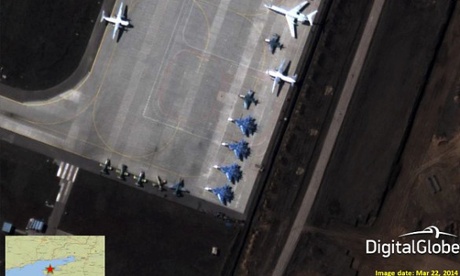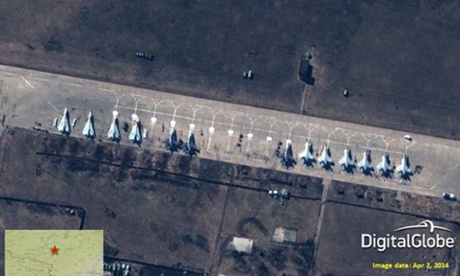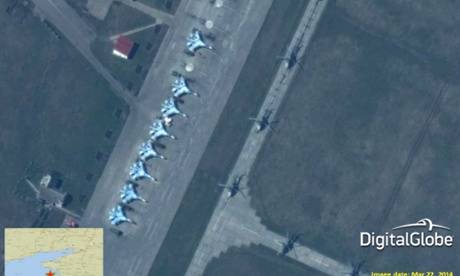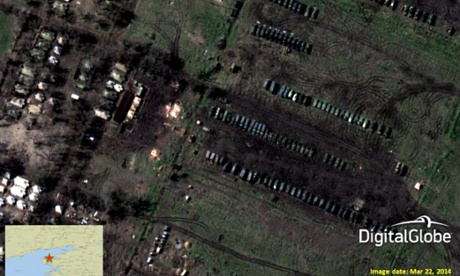Satellite images reveal Russian military buildup on Ukraine's border
Nato images show fighter planes, helicopters and troops which officials say could be ready to move in 12 hours

The images appear to undermine official suggestions from Moscow that there is nothing unusual about the troop movements, nor any reason to be alarmed.
The pictures show rows of hundreds of tanks and armoured vehicles apparently waiting for orders in fields and other temporary locations around 30 miles (50km) from the frontier. The images, taken in the past two weeks, show some of what Nato said was around 100 staging areas that were almost entirely unoccupied in February.
One of the images showed the previously empty Buturlinovka airbase 90 miles from the border now hosting dozens of fast jets, even though there are no hangars or other infrastructure normally associated with such activity. Another, of Belgorod, 25 miles from the border, showed about 21 helicopters on a greenfield site – again with no hangers or infrastructure – which officials said could be part of a forward operating base.

Deakin said between 35,000 and 40,000 Russian troops were “at a state of advanced readiness”, and could deploy “within 12 hours from a decision taken at the highest level”. With many of the troops and tanks currently based within about 30 miles from the border, that could mean crossing into Ukrainian territory within an hour of moving.
According to Nato the images reveal telltale signs of an invading force, and not merely troops on “exercise” as Moscow has claimed. The images apparently show that in Kuzminka, where tanks and infantry fighting vehicles have gathered, there are no proper barracks, significant buildings or even parking. “We just don’t see much infrastructure. There is more here than it was built for,” said Deakin.

The images were released as separatist protests in mainly Russian-speaking eastern Ukraine entered their fifth day, with pro-Moscow supporters still out in a standoff in two cities. Kiev has said protesters who seized public buildings in Donetsk, Luhansk and Kharkiv are copying events in Crimea, annexed by Russia last month.
Moscow has denied it is preparing an invading force. The Russian foreign ministry insisted on Wednesday that troops near Ukraine’s border posed no threat and the movements were nothing more than the “everyday activity of Russian troops on its territory”. But the Nato secretary general, Anders Fogh Rasmussen, dismissed these claims. “As I speak, some 40,000 Russian troops are massed along Ukraine’s borders,” Rasmussen said in Prague on Thursday. “Not training, but ready for combat. We have seen the satellite images, day after day.”

Senior Nato officials have warned that the buildup is already having a psychological, destabilising effect, helping stoke up the turmoil in eastern Ukraine. “These masked guys would not be taking over government buildings if there were not 40,000 soldiers just across the border,” said one official.
The revelations come before next week’s meeting of top diplomats from the EU, Russia, Ukraine and the United States to discuss the crisis. The meeting’s venue has still to be decided, but it will gather Lavrov, the US secretary of state, John Kerry, the EU foreign policy chief, Catherine Ashton, and Ukraine’s foreign minister, Andriy Deshchytsia.
At the same time, Nato is drawing up measures to bolster its defences in central and eastern Europe, and is likely to include a tripling of air patrols in the Baltics. Nato’s top military commander, the US air force general Philip Breedlove, will present proposals for air, land and sea reinforcements to Nato ambassadors next week. Britain is among the Nato members offering support, including four Typhoons, while Denmark has offered four F-16s and France has put forward another four, either Rafales or Mirages.
No comments:
Post a Comment